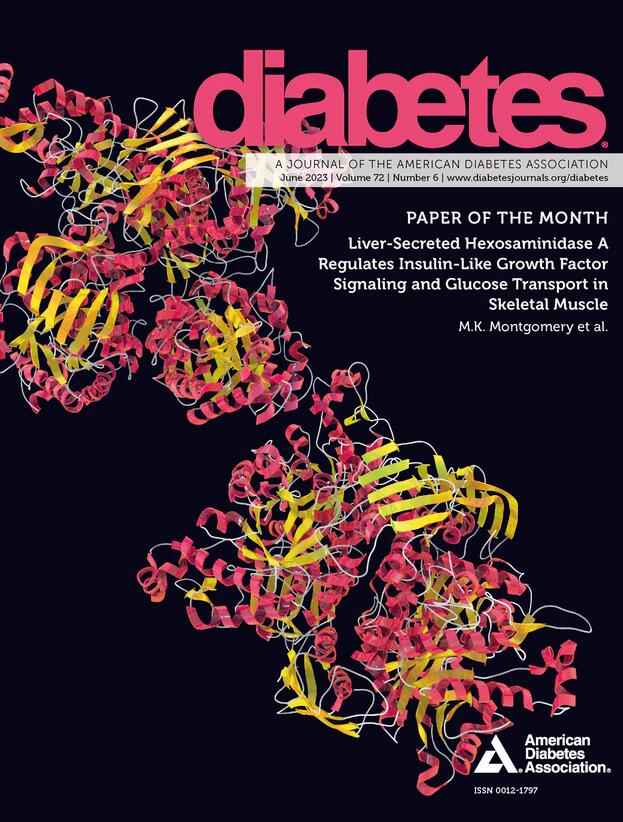Glucose-Dependent Insulinotropic Polypeptide Is Involved in Postprandial Regulation of Splanchnic Blood Supply
IF 6.2
1区 医学
Q1 ENDOCRINOLOGY & METABOLISM
引用次数: 0
Abstract
Gastrointestinal hormones are essential for nutrient handling and regulation of glucose metabolism and may affect postprandial blood redistribution. In a randomized cross-over design in 10 healthy men, the involvement of glucose-dependent insulinotropic polypeptide (GIP) in splanchnic blood flow regulation was investigated using an infusion of GIP receptor antagonist (GIPR-An) GIP(3-30)NH2 during ingestion of oral glucose (75 g). In five separate sessions, we investigated GIP(1-42), GIPR-An with and without oral glucose, oral glucose alone, and a control saline infusion. Blood flow was assessed by phase contrast MRI, hepatic oxygen consumption by T2*, and plasma glucose, insulin, C-peptide, glucagon, GIP, GIPR-An, glucagon-like peptide 2, and bone metabolism markers by frequent blood sampling during all sessions. We found GIP(1-42) to stimulate blood flow in the superior mesenteric artery by ∼10% in the fasting state. Oral glucose alone increased mean blood flow in the superior mesenteric artery by ∼70% and portal vein by ∼40% of baseline. During oral glucose ingestion with concurrent infusion of GIPR-An, blood flow in the superior mesenteric artery was ∼22% lower. The hormone infusions did not affect blood flow in the hepatic artery and the celiac artery. Infusion of GIPR-An during oral glucose ingestion resulted in lower insulin secretion and higher levels of carboxy-terminal collagen crosslinks (bone resorption biomarker) compared with saline infusion, whereas glucagon levels were unaffected by both the injection of GIP and the GIPR-An infusions. We conclude that endogenous GIP increases splanchnic blood flow and contributes to postprandial intestinal hyperemia in healthy men. ARTICLE HIGHLIGHTS Administration of the gut hormone glucose-dependent insulinotropic polypeptide (GIP) increases splanchnic blood flow. We investigated the role of endogenous GIP in splanchnic blood flow regulation using a receptor antagonist in humans. Oral glucose ingestion increased blood flow in the superior mesenteric artery by ∼70%, and the increase was significantly lower during concurrent infusion of the GIP receptor antagonist. Thus, endogenous GIP contributed ∼22% of the postprandial increase in superior mesenteric artery blood flow. We have identified a novel physiological aspect of vascular biology related to the GIP receptor in humans. Treatments targeting the GIP receptors are likely to affect splanchnic blood flow.葡萄糖依赖性胰岛素多肽参与餐后内脏血供调节
胃肠激素对营养处理和葡萄糖代谢调节至关重要,并可能影响餐后血液再分配。在10名健康男性的随机交叉设计中,通过口服葡萄糖(75 g)时输注GIP受体拮抗剂(GIPR-An) GIP(3-30)NH2,研究了葡萄糖依赖性胰岛素性多肽(GIP)在内脏血流调节中的作用。在五个单独的疗程中,我们研究了GIP(1-42)、GIPR-An联合和不联合口服葡萄糖、单独口服葡萄糖和对照盐水输注。通过MRI期相对比评估血流,通过T2*评估肝脏耗氧量,在所有治疗过程中通过频繁采血评估血浆葡萄糖、胰岛素、c肽、胰高血糖素、GIP、GIPR-An、胰高血糖素样肽2和骨代谢标志物。我们发现,在禁食状态下,GIP(1-42)能刺激肠系膜上动脉血流约10%。单独口服葡萄糖使肠系膜上动脉的平均血流量增加约70%,门静脉的平均血流量增加约40%。在口服葡萄糖并同时输注GIPR-An时,肠系膜上动脉的血流量降低了22%。激素输注不影响肝动脉和腹腔动脉的血流。与生理盐水输注相比,口服葡萄糖摄入期间输注GIPR-An导致胰岛素分泌降低,羧基端胶原交联(骨吸收生物标志物)水平升高,而胰高血糖素水平不受注射GIP和输注GIPR-An的影响。我们得出结论,内源性GIP增加内脏血流量,有助于健康男性餐后肠道充血。肠道激素葡萄糖依赖性胰岛素多肽(GIP)的管理增加内脏血流量。我们利用受体拮抗剂研究了内源性GIP在人内脏血流调节中的作用。口服葡萄糖摄入使肠系膜上动脉的血流量增加了约70%,而在同时输注GIP受体拮抗剂时,这种增加明显降低。因此,内源性GIP贡献了餐后肠系膜上动脉血流增加的22%。我们已经确定了与人类GIP受体相关的血管生物学的一个新的生理方面。以GIP受体为靶点的治疗可能会影响内脏血流。
本文章由计算机程序翻译,如有差异,请以英文原文为准。
求助全文
约1分钟内获得全文
求助全文
来源期刊

Diabetes
医学-内分泌学与代谢
CiteScore
12.50
自引率
2.60%
发文量
1968
审稿时长
1 months
期刊介绍:
Diabetes is a scientific journal that publishes original research exploring the physiological and pathophysiological aspects of diabetes mellitus. We encourage submissions of manuscripts pertaining to laboratory, animal, or human research, covering a wide range of topics. Our primary focus is on investigative reports investigating various aspects such as the development and progression of diabetes, along with its associated complications. We also welcome studies delving into normal and pathological pancreatic islet function and intermediary metabolism, as well as exploring the mechanisms of drug and hormone action from a pharmacological perspective. Additionally, we encourage submissions that delve into the biochemical and molecular aspects of both normal and abnormal biological processes.
However, it is important to note that we do not publish studies relating to diabetes education or the application of accepted therapeutic and diagnostic approaches to patients with diabetes mellitus. Our aim is to provide a platform for research that contributes to advancing our understanding of the underlying mechanisms and processes of diabetes.
 求助内容:
求助内容: 应助结果提醒方式:
应助结果提醒方式:


